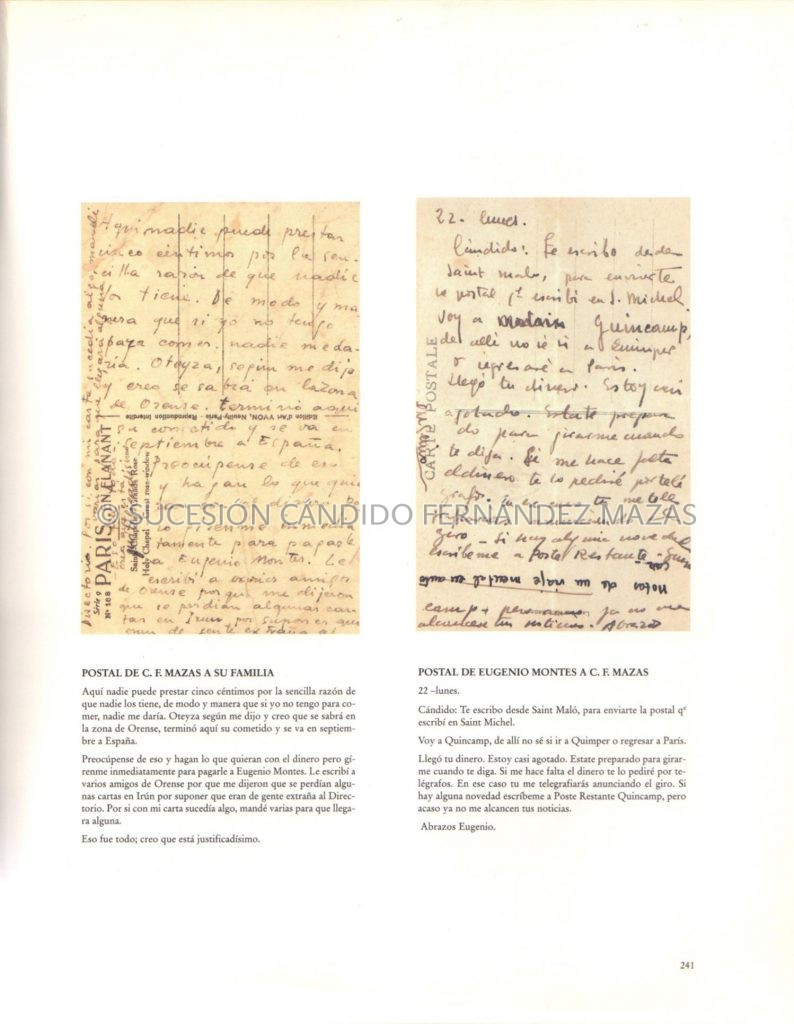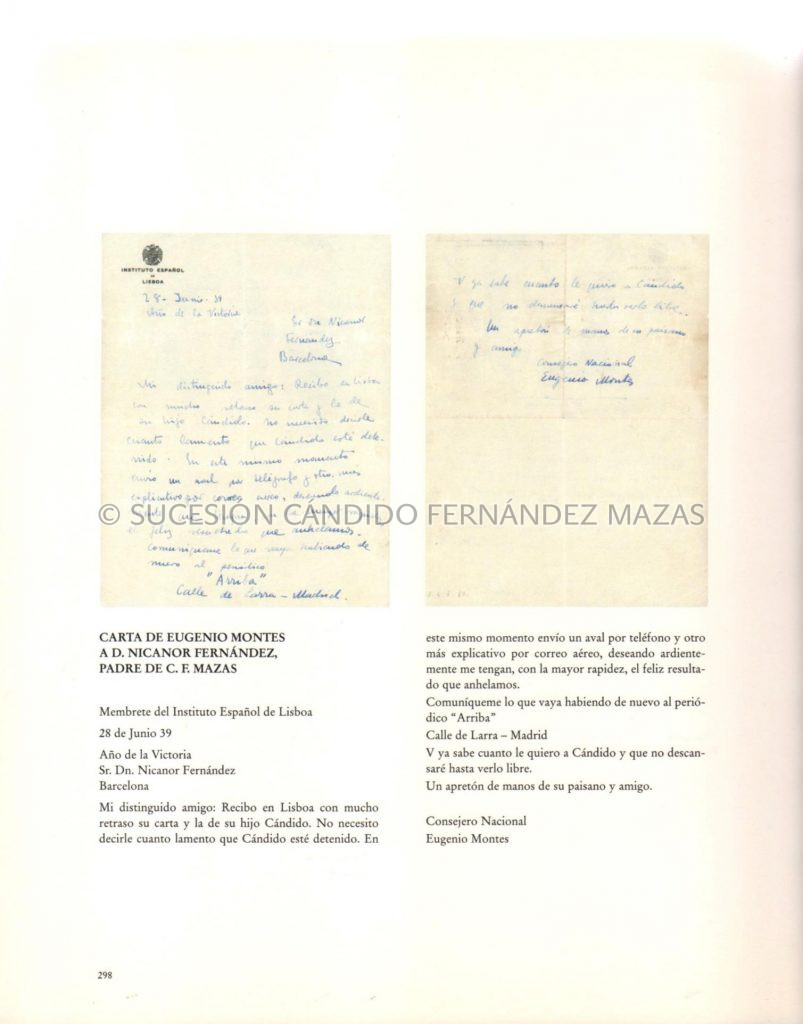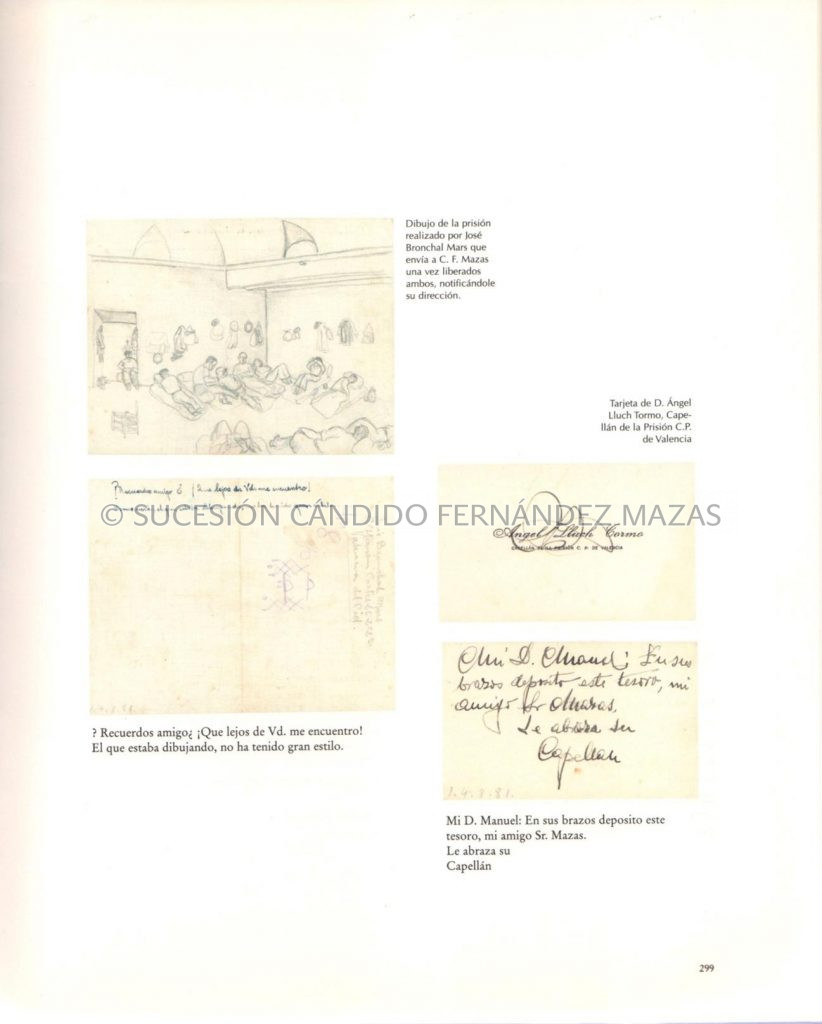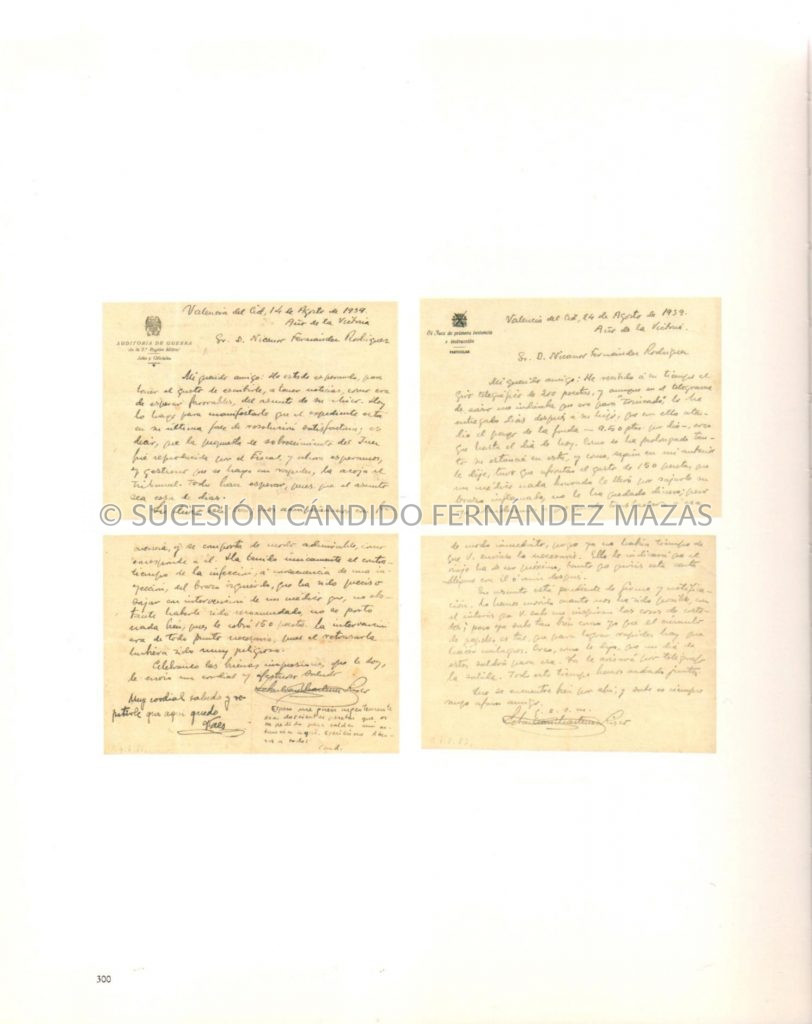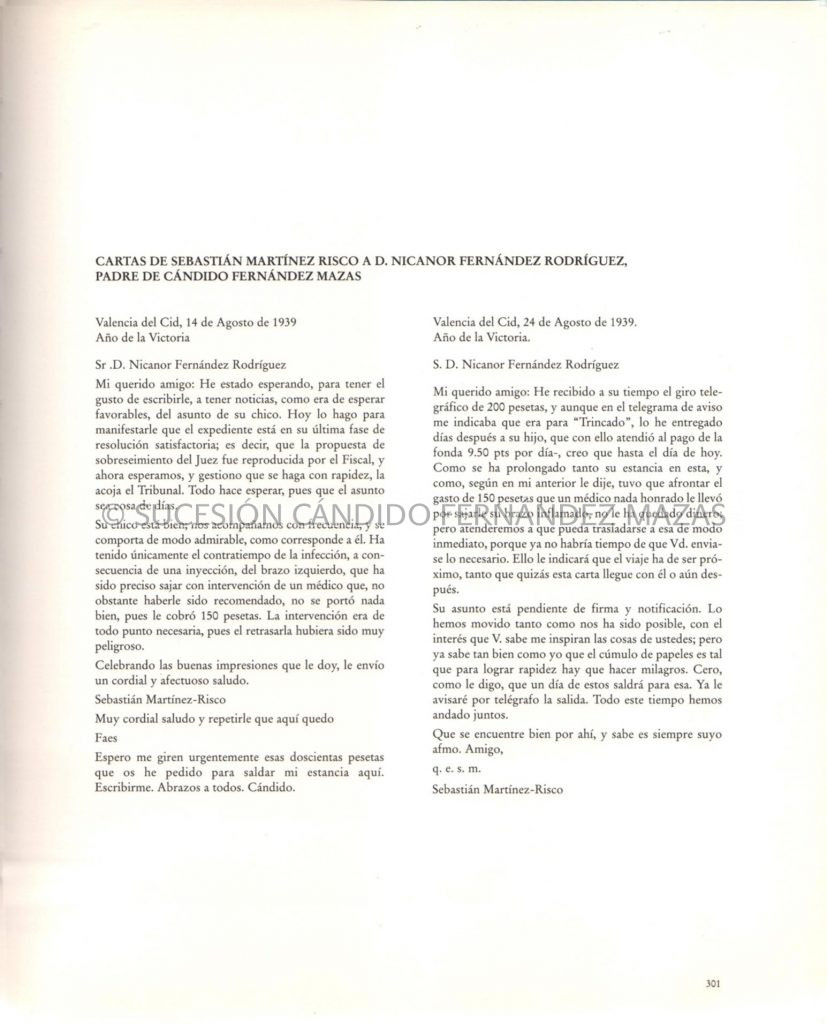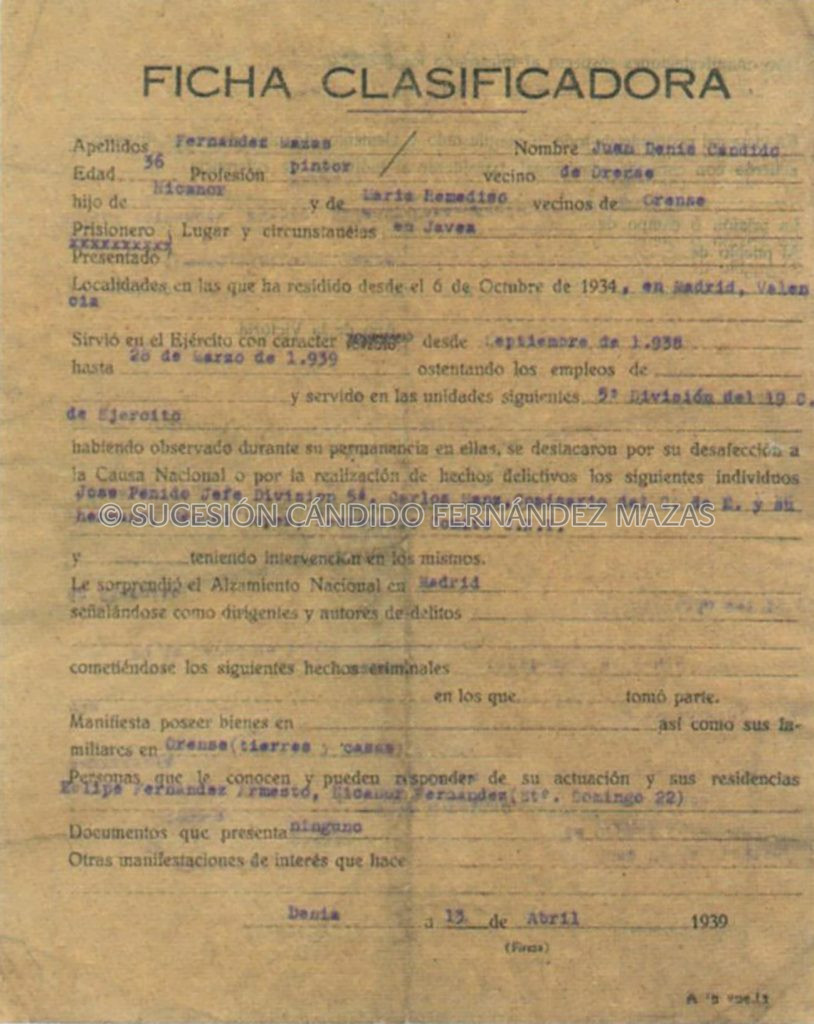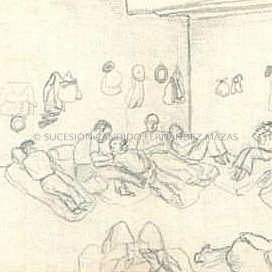The relationship between Eugenio Montes and Cándido Fernández Mazas went through mountains of admiration, valleys of disappointment and plateaus of indifference. This process appears clearer in Mazas' life trajectory. Montes, faithful to his style, preserved until the end, at least in form, that admiration and respect that he felt from the beginning of their friendship, when they were children, while Mazas used silence, prudence and distance, while discover behaviors, which did not marry, with those of the friend of past times.
To follow this process, there are two main paths and several secondary ones, which converge on the same itinerary:
1. The exhibition and publication of the catalogue:” Cándido Fernández Mazas. Vanguard, Militancy and Oblivion. 1902 – 19421, fruit of the collaboration between the Círculo de Bellas Artes and the Caixa Galicia Foundation, as a result of the centenary of its birth.
Through the legacy that could be gathered, the magnificent exhibition of the Círculo de Bellas Artes in Madrid was made, the text was printed and an itinerant tour began, from Madrid to Coruña, from Coruña to Lugo and from Lugo to Ourense. Thanks to these two milestones, and to the previous work of his brother Armando, we can approach the intellectual dimension of Cándido from different angles and perspectives, as well as the stages of his life stories.
2. José Manuel Bouzas, a key person in this process, was the curator responsible for the project. Currently, he is in charge of disseminating and facilitating knowledge of Mazas' work through the official website: candidofernandezmazas.com
The first time I discovered that the names of Montes and Mazas were related was in the reissue of the book, “Three stories by Eugenio Montes: O vello mariñeiro toma o sol, o aniño da devesa e como na parabola de Peter Breughel”, from the year 1980, which with admiration and surprise, I read and read again, both for its literary quality and for the setting where the events unfolded2, the same thing did not happen to me with Cándido Fernández Mazas “Candochas”, as the three prints of the illustration are black and white photocopies, of poor quality, which have nothing to do with the excellent illustrations of the first edition, from 1922 The artistic value of the illustrations contributed to increase the literary value of Montes' work. Now we can enjoy the cover and the vignettes, as they are reproduced both on the official Cándido website and in the catalog text, p. 211.
The second time that I find Montes and Mazas related again, is in the correspondence between Eugenio Montes and Blanco Amor3, in which Montes highlights the brilliance of his work: “He is the boy with the most soul that I have ever met. He is a man who lights up and burns.”
In the catalog text: “Cándido Fernández Mazas. Vanguard, militancy and oblivion. 1902 – 1942”, references to Montes frequently appear again. Text, which I follow in this article, focusing on the correspondence between Montes and Mazas; Montes with Nicanor Fernández Rodríguez, father of Mazas and that of Sebastián Martínez Risco Macías with Nicanor, for being related, directly or indirectly, to the thread of my research: “Eugenio Montes, through two documents”.
The two postcards, which appear reproduced, p. 241, only on the reverse, are from 1927, the year Montes and Mazas met in Paris4, both provide very valuable information (Annex 1).
In the postcard that Mazas sends to his family, he conveys his worrying lack of liquidity, verbatim, telling them: "Here no one can lend five cents for the simple reason that no one has them, so and so, if I don't have to eat, nobody would give me (…) turn me over immediately to pay Eugenio Montes”.
From the text, we can reliably deduce that Montes was lending him money to cover his basic needs.
In the postcard that Montes sent to Mazas, we verified that they maintained regular correspondence, this must have been by means of postcards, very common in Montes, and that he was also just short of liquidity. From there, his questions “did your money come. I'm almost exhausted”, “You are prepared to turn me when I tell you. If I need the money I will ask you by telegraph”.
The letter that, from the Spanish Institute of Lisbon, p. 298, sends Eugenio Montes, on June 28, 1939, to don Nicanor, father of Mazas, in response to those received, with much delay, both from the father and from his son Cándido, stands out, due to the brevity of the text , the speed of the response and the urgency of the implementation of two complementary, concrete, timely and direct action plans.
Due to the outcome of the events, Montes's plans must have been useful, at that time, being National Counselor of the Falange, in the first Year of Victory, was a position of power, prestige and respect. There is a curious fact, to avoid delays in the correspondence, Montes provides him with the address of the newspaper "Arriba" in Madrid, (Annex 2).
[Letterhead of the Spanish Institute of Lisbon
June 28 39
Victory Year
Sr. Dn. Nicanor Fernandez
Barcelona
My distinguished friend: I received in Lisbon very late your letter and that of your son Cándido. I don't need to tell you how sorry I am that Candido is in custody. At this very moment I am sending a telephone endorsement and a more explanatory one by airmail, ardently wishing that they have for me, as quickly as possible, the happy result that we long for.
Let me know what's new to the newspaper "Arriba"
Larra Street – Madrid
V already knows how much I love Cándido and that I won't rest until I see him free.
A handshake from your countryman and friend
National Councilor. Eugene Montes]
In the defense of Cándido, there were three very valuable people directly involved: Sebastián Martínez-Risco5, legal of great prestige, Nicanor Fernández Rodríguez, captain of the army, father of Mazas, who in addition to the emotional burden, must be added the economic effort of his defense and Montes, National Counselor of the Falange. In the process also appears collaterally, the chaplain of the Penitentiary Center of Valencia, D. Ángel Lluch Tormo, p. 299, on the back of his business card, he states the following: “My D. Manuel: I place this treasure in his arms, my friend Mr. Mazas. His Chaplain hugs him ”, (Annex 3).
The two surviving letters from the correspondence between D. Sebastián Martínez-Risco and D. Nicanor Fernández Rodríguez, ten days apart, (08/14/1939 -08/24/1939), pp. 300 and 301, (Annex 4), transmit excellent news for the Fernández Mazas family.
In the first, in addition to Sebastián's text, which occupies almost the entire space on both sides of the letter, at the end on the left margin, there is a short text, signed by Faes6, which everything indicates, that he was also mediating in favor of Cándido, “Very cordial greetings and to repeat that I am staying here”, and on the right margin, there is a message from Cándido to his family, “I hope those two hundred pesetas that I have given you order to settle my stay here. write me Hugs. Naive".
[Valencia del Cid, August 14, 1939
Victory Year
Mr. D. Nicanor Fernández Rodríguez
Neither dear friend. I have been waiting, to have the pleasure of writing to you, to have news, as expected, of the matter of your boy. Today I do it to tell you that the file is in its last phase of satisfactory resolution; that is to say, that the Judge's dismissal proposal was reproduced by the Prosecutor, and now we hope, and I manage that it be done quickly, that it be accepted by the court. Everything makes us wait, because the matter is a matter of days.
Your boy is fine; we often accompany each other, and he behaves admirably, as befits him. He has only had the mishap of infection, as a result of an injection, in his left arm, which has had to be removed with the intervention of a doctor who, despite having been recommended to him, did not behave well at all, since he charged him 150 pesetas. The intervention was absolutely necessary, since delaying it would have been very dangerous.
Celebrating the good impressions that I give you, I send you a cordial and affectionate greeting.
Sebastián Martínez-Risco
Very cordial greeting and repeat that I am here
Field
I urgently hope that those two hundred pesetas that I have asked you to pay for my stay here will be turned over.
write me Hugs to all. Naive].
The process was going very fast and in the right direction, the goal was about to be achieved: “the file is in its last phase of satisfactory resolution; (...) the Judge's dismissal proposal was reproduced by the Prosecutor, (...) Everything makes us wait, (...) that the matter is a matter of days."
Of the quality of the legal defense, we have absolute certainty, when D. Sebastián, writes to D. Nicanor, the file was in its final stretch. Montes, begins with his plans, on June 28, taking into account the bureaucracy, Cándido's conditions, also knowing Montes' performance in the rehabilitation processes of Ernesto Halffter; Otero Pedrayo; Vincent Risco; Cipriano Rivas Cherif, brother-in-law of D. Manuel Azaña and Augusto Assía and his wife, the implication of Montes in the process, in my opinion was evident, in approximately a month and a half, everything was resolved.
Based on the context of the two letters, Cándido was already on parole, he was paying his pension, and they had to go to a paid doctor to cure the infection in his left arm. Mazas's father was aware of the seriousness of the process, his companions were the ones who were judging his son, if he did not consider Montes's intervention valuable, he would not have written twice. Too bad I can't count on the documentation that proves my assumption.
The information provided by the "Classification File", dated April 13, 1939, p. 302, in the section “people who know him and can answer for his actions and their residences”, Felipe Fernández Armesto (Augusto Assía) appears first and then Nicanor, his father, (Annex 5)
[Valencia del Cid, August 24, 1939.
Year of Victory.
S. D. Nicanor Fernandez Rodriguez
My dear friend: I received the wire transfer for 200 pesetas in due time, and although in the warning telegram he indicated that it was for “Trincado”, I delivered it days later to his son, who with it attended to the payment of the inn 9.50 pesetas per day-, I think until today.
Since his stay in this one has been so long, and since, as I told him before, he had to pay the cost of 150 pesetas that a dishonest doctor charged him for cutting out his swollen arm, he has no money left; but we will see to it that he can go there immediately, because there would be no time for you to send what is necessary. This will indicate that the trip must be close, perhaps this letter will arrive with him or even later.
Your matter is pending signature and notification. We have moved it as much as possible, with the interest that you know your things inspire me, but you already know as well as I do that the accumulation of papers is such that to achieve speed you have to perform miracles. I believe as I say, that one of these days it will come out for that one. I'll let you know by telegraph when I'm leaving. All this time we have been together.
Good luck out there, and you know it's always yours. Dude,
q. e. s. m.
Sebastián Martínez-Risco]
The second letter, complements the first, shows again: warmth, affection, closeness, both physical and emotional, and economic support in case of need, at all times, from Sebastián to Cándido.
When analyzing all this documentation, eighty-three years later, the emotion and relief that the Fernández Mazas family must have felt beats, after the great, intense and cruel suffering of the war years: Mario, who with 20 years, he lost his life on the Teruel front, Armando hiding in a cave, so as not to be arrested and imprisoned, and Cándido, in the Valencia prison, with a risky judicial process, which with a high probability could end with a tragic outcome.
1 Candido Fernandez Mazas. Vanguard, militancy and oblivion. 1902-1942. Caixa Galicia Foundation, ISBN 84-95491-43-5 (2002)2 “Three stories of life in Eugenio Montes”. Published in Galicia Digital, no opinion section or on 08/31/2021
3 Galicia Digital. “Correspondence between Eugenio Montes and Blanco Amor” (02/05/2022), Cándido Fernández Mazas, author of the illustrations for the first edition of his book “The Old Sailor Takes the Sun and Other Tales”, (1922) and the Aesthetics of A Muiñeira ”(1923).
4 Information provided by José Manuel Bouzas: [“The two postcards are from 1927. Mazas and Montes met that year in Paris for a few months at a Hotel du Faubourg Saint Jacques. Mazas returned before the end of the grant period and not especially because his assignment ended -despite the difficulties expressed in the letters-. The reason was that: “he returns sick suffering from a strong nervous depression which, with more or less brief intervals, will not leave him for the rest of his life.” as reported by his brother Armando in Vida y Obra del Pintor Fernández Mazas on p. 56. Nervous depression brought about by the fear caused by the raids of the Italian fascists to capture, torture or kill political opponents who had taken refuge there. And even worse -in this context- having discovered Montes's double game and his new political leanings. ”]
5 Sebastián Martínez-Risco y Macías (Ourense 1899 – A Corunha 1977). He studied Law. He entered the judicial career, exercising it in different locations. He participates in the release of Mazas together with another judge, Díaz-Faes. Mazas portrays them both. He published various books such as the novel La Tanza Negra (1943) and Do Recuncho Amado (1980) with illustrations by Cándido Fernández Mazas.
6 José Manuel Bouzas, maintains a different hypothesis than mine, regarding the role of Montes: “Regarding the leading role in the liberation of Mazas, more than what Montes could have achieved (until the contrary is proven) were the efforts of the judges Faes and Risco and the Mazas family. The most decisive thing was undoubtedly the intervention of the judges (professionals of their own although in civil procedures) before the military court and where Don Nicanor (who was part of military courts similar to the one that judged his son) and very probably Assía had an influence. .”
